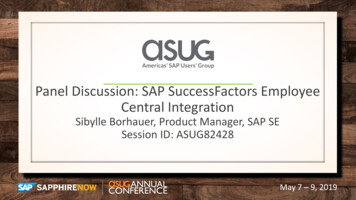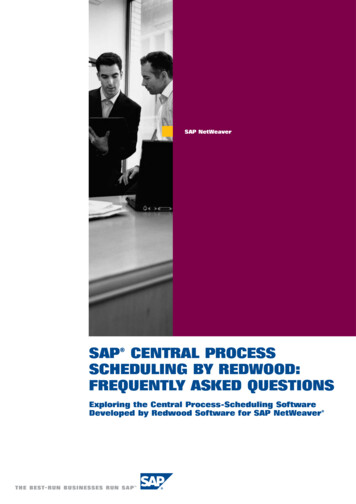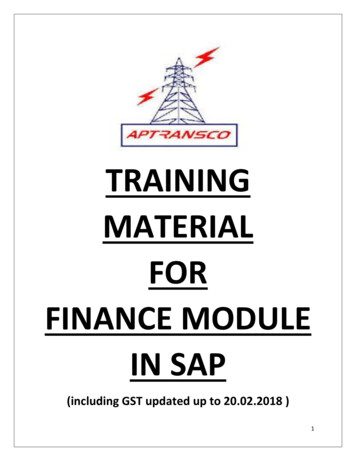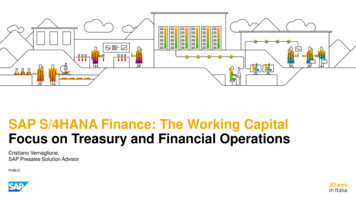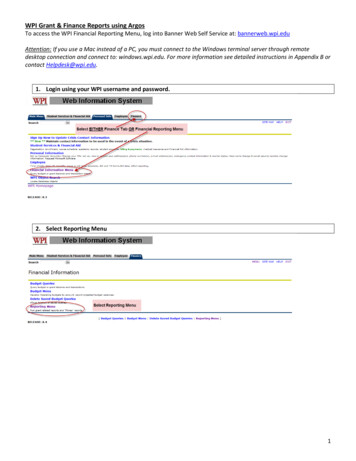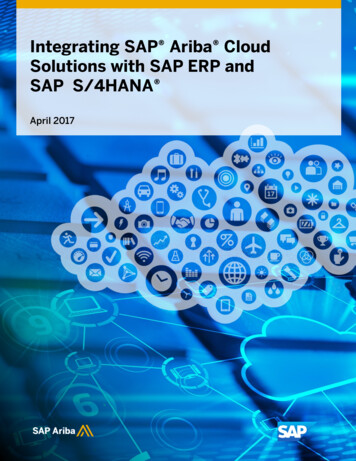
Transcription
USING SAP CENTRALFINANCE TO BEGIN YOUREVOLUTIONTO SAP S/4HANA Most SAP customers will eventually need tomove to the SAP S/4HANA platform. Butwhat is the most effective way of gettingthere? Taking a full migration approach canbe disruptive and invasive to a company.Instead, companies can use SAP CentralFinance as a means of gradually evolvingtoward the SAP S/4HANA world, reapingvalue at each step along the way.
THE ADVANTAGESOF AN EVOLUTIONARYAPPROACHThe majority of large SAP enterprise customers are onversions of SAP software that are showing their age.These systems include one-size-fits-all user interfaces andapplications that cannot deliver a single source of “truth”for the enterprise. They also fail to take advantage ofintelligent technologies and innovations such as in-memorycomputing, real-time analytics, machine learning, artificialintelligence, big data, cloud or the Internet of Things. Thatmeans companies cannot access on-demand analyticsto discover insights and value in the large amounts ofdata generated by the business. They also cannot deliverintuitive, easy-to-use, go-anywhere, task-specific andaction-oriented user interfaces for business users.What is a company to do in that situation? One answer isSAP Central Finance. Eventually, most SAP customers willneed to migrate to the SAP S/4HANA platform. But in theshort term, given the time and millions of dollars invested inexisting systems, what is a more effective and cost-efficientway to proceed?In this paper we’ll explore how SAP Central Finance canhelp companies take an evolutionary approach to SAPS/4HANA rather than engaging in an invasive migration.First we’ll look at how Central Finance improves the overallfinance function. Then we’ll provide more detail on usingCentral Finance as a means of moving in an evolutionarymanner toward SAP S/4HANA.2 S/4Central Finance
SAP CENTRAL FINANCE:CREATING A WORLD-CLASSFINANCE FUNCTIONCompanies today expect the financeorganization to be more agile, forwardlooking and decision centric. For theoffice of the CFO, this means creatingmore tangible insights from thevolumes of data flowing through thecompany's ERP systems. Stakeholdersare increasingly demanding access tothe right information at the right time tomake the right decisions. These trendsunderscore the need for agileinformation technologies and solutions.One global instance of finance datain Central Finance can improve theefficiency and effectiveness of thefinance function. The Central Financeinstance contains all universal journalpostings from upstream ERP systems,making it more effective in managing:SAP Central Finance allows users tocreate a global, common reportingstructure by mapping accountingentities in upstream systems to onecommon set of master data in theCentral Finance system (for example,general ledger account, profit center orcost center). Revenue recognitionThe centralized (or global) postings offinance data into the Central Financesystem as universal journal postings(a.k.a., single source of truth) allowthe office of the CFO to run thecomplete range of harmonizedfinancial reports efficiently. Thisprovides a solid base for thecompany's long-term decision-makingcapabilities and business strategies.In some cases, accounts payable,accounts receivable and payroll usershave to use multiple systems in aheterogeneous landscape to performtheir duties. Centralizing financial datainto a single global instance with CentralFinance provides an improved platformfor financial planning, resulting inreal-time planning data that facilitatesproactive and predictive financialreporting capabilities. The platform alsoimproves the productivity and efficiencyof shared services operations. Financial close tasks Cost assessments Cash flow management Rebate calculationsA Central Finance instance also enablesthe office of the CFO to be moreproactive in managing the financedecision-making process and can leadto reduced time to close the books.Additional benefits include improvedprocess efficiency, reduced total costof ownership (TCO) and harmonizeddata to assist the finance team inmeeting their stakeholders’ needs.Central Finance can be implementedon-premise, in the cloud or as asoftware-as-a-service solution. Each ofthese implementation methods deliversaccess on any device, instant insights,and a task-based, actionoriented SAPFiori interface3
Additional benefits that can be realized by deploying SAP Central Finance Global, unified, real-time financial and management reporting Enterprise-wide data governance for materials, customers, vendors, banks andgeneral ledger accounts Standardization of finance and accounting data and processes to create a fullfinance template:- Global, standardized financial organizational data such as cost centers, profitcenters, and segments/business units- Intercompany processes and reconciliation- Corporate/group allocation- Centralized accounts receivable/accounts payable/asset/material ledger- Treasury and cash management- Budgeting/planning and forecastingSAP CENTRAL FINANCEAS AN EVOLUTION, NOT AMIGRATION, TO SAP S/4HANAThe Central Finance environmentis an SAP S/4HANA EnterpriseManagement (EM) instance that canbe utilized as the initial entry point toa business’s SAP S/4HANA platform.The SAP S/4HANA EM instance has theappropriate finance functionality toenable Central Finance. SAP LandscapeTransformation (SLT) technology isleveraged to integrate the upstreamERP system(s). The SAP Central Financesystem can then be configured for yourorganization’s new or global chart andother key master data objects.SAP S/4HANA is the right destination foryour business, but it can’t be reachedin a day. By using an evolutionaryapproach with Central Finance, you arebetter able to take step migrations tothe SAP S/4HANA EM environment. Youcan plan or develop your SAP S/4HANAmigration roadmap as SAP develops thefull capabilities needed for yourprocesses and business.4 S/4Central FinanceStarting the SAP S/4HANA journey witha Central Finance instance is a noninvasive approach for your organization.The upstream ERP system or systemscontinue to be operated as theycurrently are today. You can takeadvantage of the functionality andassociated benefits within the CentralFinance instance immediately. You canbegin the SAP S/4HANA journey by firstreassessing your organizationalstructure and master data—dataelements such as the chart of accounts,cost centers, profit centers and keymaster data elements such ascustomers and vendors.These elements will be redesigned anddeployed to your Central Financeinstance and mapped to your existingchart and master data elements.
The evolutionary approach to SAPS/4HANA gives your organizationthe opportunity to rationalize andimprove the quality of key systemdata elements, all while buildingout your Central Finance instance.Master data elements shared betweenthe new Central Finance instanceand the upstream ERP system(s) arekept in sync by using SAP’s MasterData Governance (MDG) modulefunctionality. With the Central Financeapproach you are fundamentallydesigning and building your enterprisesystem for the future while continuingto operate as you do today with yourupstream ERP system(s).If your company has only one highlycustomized global instance of SAPECC, Central Finance can be yourdeployment path to SAP S/4HANA.Over time, your organization hasprobably designed and built a numberof customization and configurationlayers that were needed due to yourcompany’s evolving and changingbusiness model and needs. Theseconfigurations and customizationsmay have also led to a proliferationof master data objects that are nowcorrupt, non-standard and unusable.By moving first to a Central Financeinstance rather than developinga standalone greenfield instanceimplementation, your organization cantake advantage of the SAP S/4HANAtechnology and its related financebenefits immediately while the full suiteof SAP S/4HANA EM matures over time.With Central Finance, organizationswith a single SAP ERP instance andorganizations with heterogeneous,multi-ERP system landscapes withlittle appetite for a large migration orupgrade project can take advantageof SAP’s finance innovations in anondisruptive fashion while providingfor business continuity. This approachoffers several important capabilities:DIGITAL DATA ARCHITECTURE:Flexible and extendable coding blockto record and report external financialaccounting data as well as all businessperformance-relevant (microsegment)business dimensionality. Dynamicattributes for enhanced analysis canbe acquired through virtual queries.Revenues and cost are broughttogether to provide margin/ profitinformation on a micro-segment level.All financial transactions are onlystored once (single source of truth)in a central financial transactionleveldata repository. This provides reportingand analytics on top of a single dataset without replication to reportingsystems or data warehouses. Thismeans that data is stored only once,without additional replication andduplication for planning, and onlyonce centrally across the organizationin case of heterogeneous SAP and/ornon- SAP system landscapes.ABILITY TO SUPPORT GROWTH:Managing change, organic or inorganicgrowth, and internal business modelconcepts such as process automation,shared services or even zero-touch/exception-based finance operations.Also supported are modeling andsimulation of reorganization activities;automatic adjustments to marketsegment reporting without (physical)realignment of financial postings, andrestatement of key financial reports,and the ability to "plug in" entitiesfollowing a merger or acquisition.CAPACITY TO EXTEND BEYOND THECORE: In the digital economy, realtime interaction rather than integrationis the new standard. Pre-definedplugins, add-ons, and digital or cloudconnectors have replaced customintegration and, through functionaldepth, have surpassed traditionalcustom integration.5
SAP S/4HANADEPLOYMENT OPTIONSWhen deploying SAP S/4HANA, itis possible to tailor an adoptionroadmap—using SAP CentralFinance— that addresses the specificareas of need or weakness in thecurrent finance and accountingsystems, processes and data. Forexample, an enterprise can chooseto define its own adoption pace,phasing, sequencing and prioritieswhile retaining the option to pauseat any defined phase if businesscircumstances change. The followingare alternative deployment options:1. CENTRAL FINANCE. An enterprisehas operational ERP(s) with diversebusiness processes and/or businessmodels and therefore prefers to retainthem as-is while enabling unified,real-time financial and managementreporting across the enterprise.2. CENTRAL FINANCE WITH SYSTEMCONSOLIDATION. In addition to globalfinancial and management reporting,an enterprise chooses to create a fullfinance global template while retainingthe operational ERP(s) for supply chainprocesses. Based on the appetitefor change and business need, anorganization can choose to standardizeand centralize some or all of itsfinance and accounting processes.The organization can consolidate itsdisparate finance and accountingsystems into its new finance templateand retire them.3. GREENFIELD. An organization usesconsolidation of financial systemsas the stepping stone to create a fullERP global template taking a "globalredesign" approach to ERP systems,processes and data over time (ratherthan a big-bang approach).4. BROWNFIELD. This migrationoption is for an enterprise running asingle global ERP instance or in theprocess of rationalizing its multiERP environment. An organizationcan choose to take a "big-bang"enterprisewide upgrade path or a "bitesized or phased" approach beginningwith a technical upgrade and thensteadily introducing incrementalfunctionality improvements to addressspecific prioritized business processpain points.CENTRAL FINANCE & THE CLOUDToday the cloud and as-a-serviceoptions are becoming increasinglymainstream: infrastructure (IaaS),platform (PaaS), and software (SaaS)can be provisioned and consumed in amatter of hours without makinginvestments or allocating resources totechnical and support activities thatare not core competencies. Adoptioncan be fast, standardized andextremely economic.6 S/4Central FinanceCentral Finance can be deployed in thecloud without (on-premise) provisionand infrastructure or applicationsupport through SAP and third-partycloud providers. With the cloud option,production and project-based cloudsystems can be provisioned in as littleas 24 hours to start an implementationor rollout project
CONCLUSION:CENTRAL FINANCE &THE SAP S/4HANA JOURNEYSAP Central Finance can be the meansto launch your organization on the SAPS/4HANA journey. It provides a noninvasive approach to adopting financialbenefits from the SAP S/4HANA platform.address configuration improvementsto take full advantage of SAP S/4HANAfunctionality. Central Finance canquickly help your organization developone global instance of financial data.Starting the SAP S/4HANA journeywith a Central Finance instance cangive you the benefits of a greenfieldimplementation over time withtransformational system and processimprovements. The initial focus isto standardize the master data andCentral Finance offers the flexibility tobegin the SAP S/4HANA journey—takingadvantage of its power and functionalityfirst in finance and then using that as thefoundation for an organization's nextgeneration SAP solution.ACCENTURE MYCONCERTOAccenture myConcerto powers finance transformation from business case toroadmap to delivery, helping companies make the right investments, navigatecomplexity and realize value quickly.myConcerto is an insight-driven, digitally integrated platform that orchestratesthe power of new SAP solutions and technologies, and Accenture’s industryand functional expertise—methods, tools, solutions, capabilities—to createexponential business outcomes.The journey starts with design thinking to identify specific business challengesand differentiators
In this paper we’ll explore how SAP Central Finance can help companies take an evolutionary approach to SAP S/4HANA rather than engaging in an invasive migration. First we’ll look at how Central Finance improves the overall finance function. Then we’ll provide more detail on using Central Finance as a means of moving in an evolutionary manner toward SAP S/4HANA. 3 SAP CENTRAL FINANCE .




